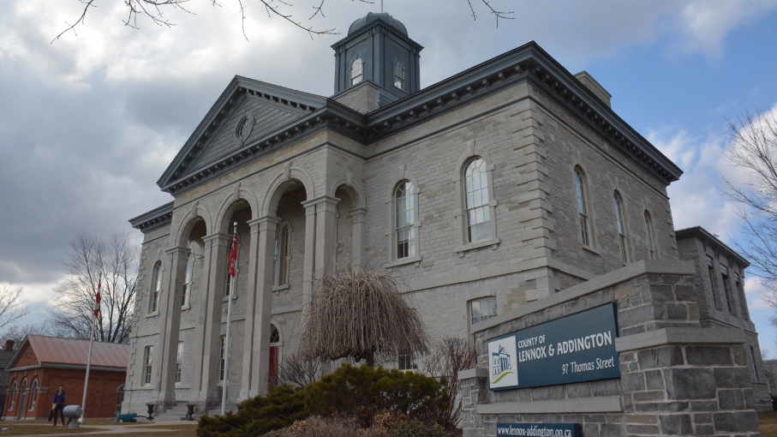Adam Bramburger
Beaver Staff
Lennox and Addington County will apply to the Province to end a tax rebate program for the owners of vacant commercial and industrial units starting with the 2020 taxation year.
Councillors supported a staff recommendation to that effect last Wednesday, signalling the end to a program that has been in place since 1998. Director of physical and financial services Stephen Fox reported that the program, which offers mandatory rebates to eligible properties of 30 per cent in the commercial tax class and 35 per cent in industrial, to compensate for lost revenue incurred from a change from business occupancy tax to market assessment.
Fox noted that the assessment process the Municipal Property Assessment Corporation uses often factors in vacancy impacts or obsolescence directly, so the rebate program can offer a duplication in savings to those property owners. The reliefs were intended to address temporary conditions, but the County was discovering few properties were removed from the list of those eligible.
“The program was intended to provide relief in instances of temporary and sporadic conditions, however many properties remain eligible for years at a time or indefinitely,” Fox reported. “Repeat vacancies (recurring over the past two years) within Lennox and Addington approximate 75 per cent of the applications received last year.”
In some instances, Fox also said the rebates may provide incentive for property owners to hold title to buildings for speculative purposes and not seek tenants. That can have a negative impact on economic growth and job creation.
In 2017, the Province offered municipalities flexibility to change or eliminate the rebates by undertaking a consultation process, then applying for changes. Last year, four eastern Ontario counties took that approach. Northumberland ended the program immediately in 2018, Renfrew eliminated it for this year, Leeds and Grenville in 2020 and Peterborough in 2021.
In concert with the four lower-tier municipalities, the County engaged in a required public impact process via an online survey and a public meeting Jan. 21. The meeting was attended by 10 members of the public — four of whom were Greater Napanee councillors. Two attendees provided written follow up. Another 24 returned the survey.
Among the feedback, Fox indicated there was concern about impact of vacancies on property standards and other businesses. There was consideration also that elimination of the program might lead to demolition of buildings. Some also raised concerns about the costs of the program.
Two good suggestions were highlighted. One noted the money that would have been spent be redirected to economic development or streetscape improvements. Another suggested that if council kept the program, it should consider eliminating rebates for frequent users.
Should the Ministry of Finance accept the request, there would be a total tax impact of $117,221 based on 2018 taxes, a cost that had been largely borne by residential taxpayers.
The County would save $29,582. Greater Napanee, with the greatest instance of commercial and industrial properties would save $25,354. Loyalist would save $8,723, Stone Mills, $2,777, and Addington Highlands $903. Since commercial and industrial tax classes pay heavily into education, the move could also mean an additional $49,882 would go into school systems.
The Province also invited municipalities to weigh in on a similar-scale tax reduction for vacant lands. Scrapping that program would have meant a savings of $163,805 for the County, $117,473 for Greater Napanee, $69,253 for Loyalist, $15,855 for Stone Mills, and $1,741 for Addington Highlands. It would also have an education tax impact of $245,973.
In his research on other counties’ decisions, Fox said many hadn’t yet considered eliminating the reductions and added he wasn’t comfortable bringing a recommendation to do so at this time.
Also Wednesday, councillors reviewed a staff report on tax ratios but did not take any action, other than to reduce the landfill ratio to 2.13 per cent as mandated by the province. There was some discussion about a target the Province had established to bring multi-residential, commercial and industrial classes to the same rate of taxation as residential. Currently, in Lennox and Addington, a multi-residential property owner pays $2 in taxes for every $1 spent by a residential taxpayer. A commercial ratepayer pays $1.42, an industrial ratepayer $2.17 and a large industrial ratepayer $2.73. Farmland is taxed at 23 cents compared to the residential dollar — a response to an 87 per cent surge in market values for farmland that has seen property taxes increase by close to 20 per cent a year due to phased-in assessment.
Fox indicated the shift to a dollar-for-dollar payment for multi-residential, commercial and industrial would have resulted in a 7.3-per-cent increase in the residential tax rate.
Napanee’s Marg Isbester wondered if council could find a way to encourage multi-residential uses, perhaps by changing the definition of multi-residential as six units. While Fox said that’s a standard definition, Isbester said a review could help the affordable housing crisis.
“We’re hitting the areas that probably make the best use of municipal services,” she said. “We hit them with development fees, impost fees and, then, a higher tax ratio. On one side we’re taking from them, on another side we’re taking even more.”
Fox said in 2004 the County did introduce an exemption on new multi-residential builds, taxing them at the same rate as residential dwellings in hopes of encouraging development. He noted that existing multi-residential developments aren’t enjoying the same benefit.
“It would be nice for it to go down to the same level for equity reasons,” he said.
While Fox said he understood the new provincial government would look to lower multi-residential tax rates, he also said it might be something worth advocating for.
“Council is seeing that housing and homelessness are big issues. Whatever we can do to encourage multi-residential development would be useful to resolve these issues.”

